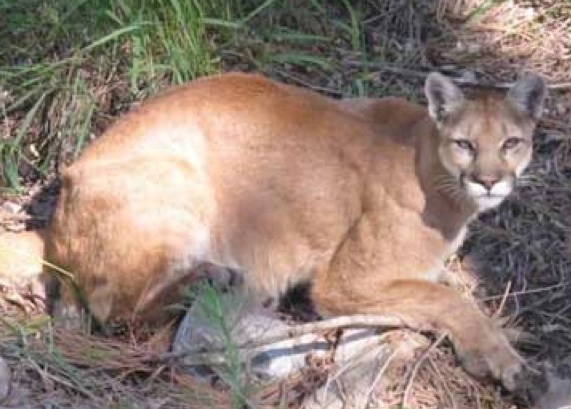McGill residents receive an unexpected and unwanted visitor last week in the form of a mountain lion.
“It was in the storage yard fenced area between and behind the storage sheds between town and the pool and my barn… In front if the slag pit..” wrote Michelle Bodenheimer. “My friend took a big gun and some hunting dogs out right away..!
So many parents just send their little kids walking right past there to go to the pool during the day..
 “I think lions hunt in the early morning and evening.. He was most likely looking fur a shady spot to sleep during the day..”
“I think lions hunt in the early morning and evening.. He was most likely looking fur a shady spot to sleep during the day..”
“It was probably a yearling,” said White Pine Under Sheriff Scott Henroid.
While mountain lion sightings are rare they are not unheard of especially in rural Nevada and especially in the last 20 years.
American mountain lions, or cougars, are re-emerging in areas of the United States, reversing 100 years of decline according to a report from the Journal of Wildlife Management, raises new conservation questions such as how humans can live alongside the returning predators.
In Nevada cougars have been a big game species since the 1960’s while the state never offered a bounty on the animals.
The return of the cougar to rural Nevada may coincide with similar comebacks of other wild life. This winter once locally extinct bald eagles are now commonly reported ‘roadside attractions’ in northern Nevada.
Bald Eagles are not the only iconic wild animals to return to Nevada. Just last summer a small herd pronghorns, the fastest North American, mammals took a mosey threw Wendover on their annual migration north for the summer.
The pronghorn can reached speeds of over 60 miles an hour for over five minutes is the pronghorn is bested only by the cheetah in a sprint. But while the cheetah can achieve 80 miles an hour, it can only sustain that speed for at best 100 yards, a pronghorn can maintain its top speed for over five minutes.
 Like the eagle and the cougar the 20th century was not kind to the pronghorns by the 1920’s the entire number of pronghorns was estimated to be only 13,000. Protection of habitat and hunting restrictions have allowed their numbers to recover to an estimated population of between 500,000 and 1,000,000.
Like the eagle and the cougar the 20th century was not kind to the pronghorns by the 1920’s the entire number of pronghorns was estimated to be only 13,000. Protection of habitat and hunting restrictions have allowed their numbers to recover to an estimated population of between 500,000 and 1,000,000.
In the last 50 years pronghorns have recovered almost exponentially and part of the reason like other native wildlife could be due to increased toleration of human beings.
Described as extremely skittish well into the 1950, pronghorns like the recent visitors to Wendover have appeared to have learned that people especially those living in cities pose little threat to them.
This acclimation to humans and the exploitation of new food sources is not unique to the pronghorn. The once rare desert big horn sheep is an annual winter visitor to Wendover as are mule dear and elk.
While herbivores are tolerated if not welcomed to the new human built oasis predators such as coyotes, wolves, bobcats and cougars have also tried to make inroads into areas of human habitation with often fatal results.


